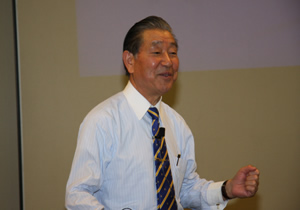
Japan Institute of Human Factors (JIHF)
Akira Ishibashi, Director of Research & Development
|
(1) Lecture:
"Training for a New Era -Trying the CRM Training Proven Successful in the Airline Industry-"
Akira Ishibashi, Director of Research & Development, Japan Institute of Human Factors (JIHF)
Mr. Ishibashi, Director of Research & Development for the Japan Institute of Human Factors (JIHF), gave an introductory lecture on CRM training.
CRM is an acronym which stands for Crew Resource Management, and was developed by the airline industry. The major idea in CRM is "effectively utilizing all available resources within the cockpit for safe operation (in this case, all crew, machines, and information,) while displaying team work performance ability through appropriate decision-making." The term "CRM training" covers the training carried out to develop these skills.
Development and research for what would become CRM training began almost 30 years ago. The major cause for its development was the alarming increase of CFIT (Controlled Flight Into Terrain) accidents, which seemed to accompany advances in aeronautics. The term "CFIT accident" refers to cases where accidents occur despite the lack of serious aircraft malfunction; their frequent occurrence lead to the emphasis placed on measures to deal with human factors. Famous examples include: Eastern Airlines Flight 401 (a Lockheed L-1011 which crashed into the Florida Everglades); United Airlines Flight 173 (a Douglas DC-8-61 which crashed in Portland due to fuel starvation); and the Tenerife airport disaster, where two Boeing 747 airliners collided on the runway. The main causes of these accidents were determined to be "improper decision-making" by veteran pilots, and their "failing to recognize the situation." This conclusion was reached after in-depth research and analysis of the underlying factors in these CFIT accidents. Shortly after, the CRM training regimen was created in order to found a "Culture of Awareness" to address the emergency issue of "making veteran pilots realize the importance of safety."
An effective method to make veteran pilots aware of this is to organize relevant information and then to have a discussion with them. By holding these discussions, where pilots are able to fully utilize their years of experience, they could realize many things; perhaps, for example, by learning the value and importance of communication. If they become aware of new values, then these new values will become a part of their awareness process; and ultimately, will be reflected in their actions.
The training process is set up so trainees may learn techniques related to the five elements of CRM, which are: "Communication," "Decision-making," "Making a Team," "Recognizing the Situation," and "Workload Adjustment." Each element is comprised of three sub-items, for a total of 15 CRM techniques available.
Thanks to the exhaustive implementation of these CRM techniques, the airline industry has been able to realize safer operations. One famous example would be United Airlines Flight 232 in 1989, where a Douglas DC-10 aircraft performed an emergency landing in Sioux City, Iowa. All aircraft hydraulic systems had been disabled in this accident, similar to Japan Airlines Flight 123; however, due to the timely use of CRM techniques, over half of the passengers and crew were able to survive.
Currently, CRM is a subject of interest in many other fields, and has the proud achievement of being introduced into fields such as shipping, aviation control, medicine, manufacturing, and rail. |







